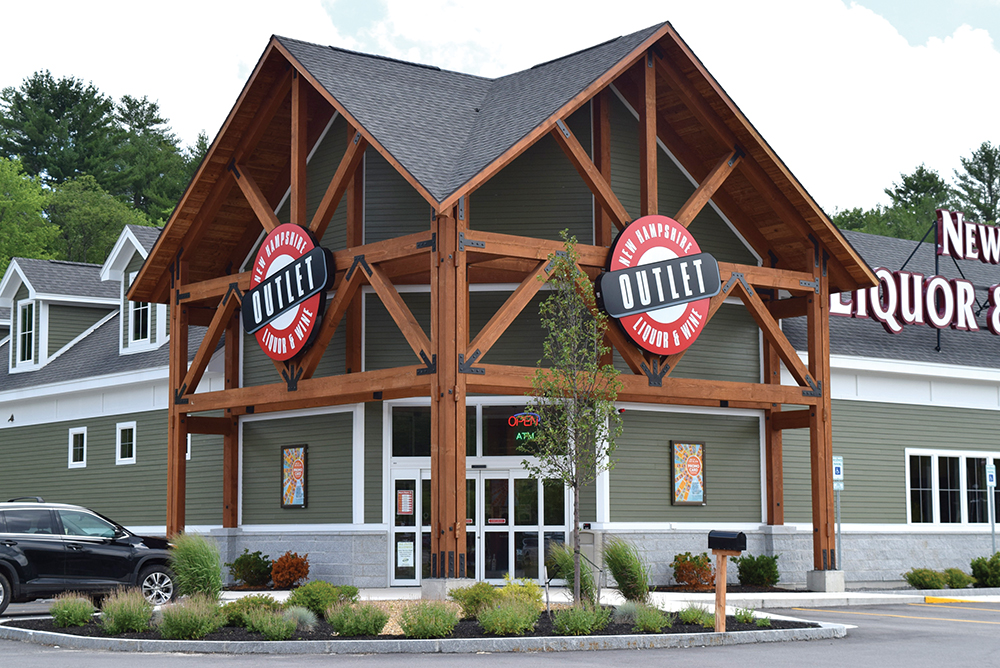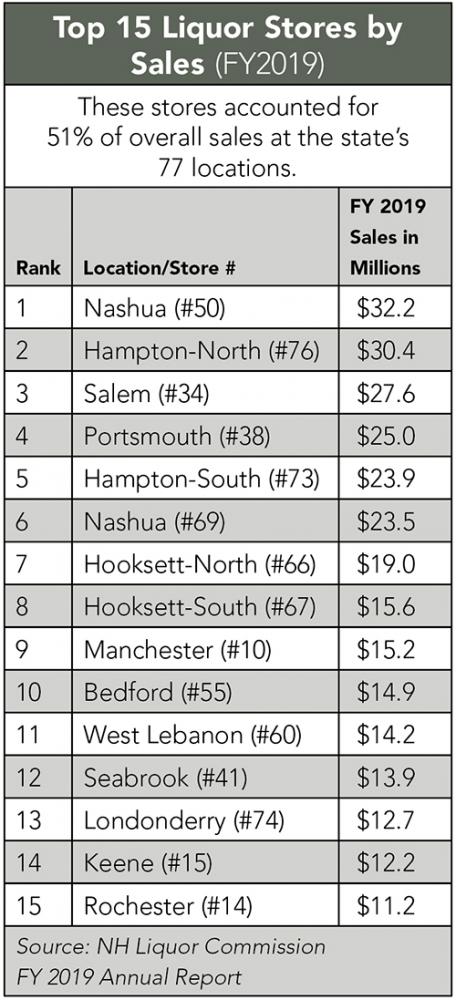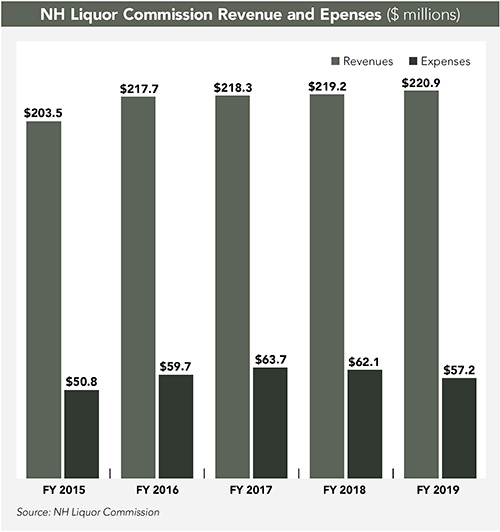
Left: NH Liquor & Wine Outlet in Warner. Courtesy photo.
New Hampshire’s liquor stores are so ubiquitous that some joke they should become the new state symbol. They bring in millions to the state’s coffers, but creating high performing retail outlets didn’t happen by happenstance. Under the leadership of Joe Mollica, the Liquor Commission has been updating stores to make them more attractive to consumers and increase revenue.
 And it’s working. Celebrating its 85th anniversary in 2019, the Commission’s 2019 annual report shows that it broke an all-time record, generating $706.1 million in net sales last year, an increase of $14.2 million from FY 2018. Liquor net profits hit $162 million, contributing $146.3 million to the state’s General Fund and $8.4 million to the NH Alcohol Abuse Prevention and Treatment Fund. The commission is also a major employer in the state, boasting 1,400 employees.
And it’s working. Celebrating its 85th anniversary in 2019, the Commission’s 2019 annual report shows that it broke an all-time record, generating $706.1 million in net sales last year, an increase of $14.2 million from FY 2018. Liquor net profits hit $162 million, contributing $146.3 million to the state’s General Fund and $8.4 million to the NH Alcohol Abuse Prevention and Treatment Fund. The commission is also a major employer in the state, boasting 1,400 employees.
Such results stem from a long-term plan to invest in the state’s retail outlets. Since 2012, the Liquor Commission has renovated more than one third of its stores. “We are pulling away from old, outdated strip malls to be placed alongside national and regional retailers such as Market Basket, TJ Maxx and Dunkin, turning locations into a destination shopping experience,” says Commission spokesperson E.J. Powers. “When our partners are building, they are actively courting us. We are an anchor tenant.”
In FY 2019 alone, the commission spent $40.8 million on buildings and building improvements, up from $35.2 million the previous year. It also closed the books with $3.2 million of construction in progress.
In the past year, the NHLC opened a new 19,000-square-foot outlet in West Lebanon and a new 20,000-square-foot Tri-City NH Liquor & Wine Outlet on the Dover-Somersworth line and announced plans to construct two 12,000-square-foot outlets in Tilton and Epsom.
A Decade of Transformation
When Mollica was appointed chair of the Liquor Commission (NHLC) in 2010, he inherited a fleet of stores that didn’t exactly scream high-end retail. “The presentation was sub-par, tucked into the corners of strip malls. Even the highway stores were barn-like structures next to the restrooms,” says Powers.
Mollica came to the job with a background of building businesses in the wine and spirits industry as well as restaurants, giving him insight into how the liquor commission was working and how it could be improved. “When I was approached about becoming commissioner, I was tasked with running NHLC more like a business and maximizing revenues. Having been a successful restaurant owner and licensee in New Hampshire for 15 years, I had a unique perspective on what the New Hampshire Liquor Commission was doing well and where it fell short,” says Mollica.

Marketing, branding and customer service were three key areas in need of improvement, he says. “Ten years later, with a nationally recognized New Hampshire Liquor and Wine Outlet brand, numerous accolades, 12 million annual customers, strong industry partnerships and $200 million in increased sales, we are making significant progress,” he says.
 That includes building stores that are more energy efficient and meet LEED standards. “It makes good business sense to have LED lighting and high-efficiency HVAC,” Powers says. “We are also improving the customer experience [with] wider aisles, special sections for high-end products, and even an industrial kitchen in Nashua to create food and wine pairings.”
That includes building stores that are more energy efficient and meet LEED standards. “It makes good business sense to have LED lighting and high-efficiency HVAC,” Powers says. “We are also improving the customer experience [with] wider aisles, special sections for high-end products, and even an industrial kitchen in Nashua to create food and wine pairings.”
Emphasis on Partnerships
The Commission is also creating public-private partnerships, as it did with the Hooksett welcome centers, where it partnered with Granite State Hospitality to create a rest area with not only liquor stores but a Common Man mini restaurant, a store and an attractive visitor lobby. The welcome center in Hooksett expanded from two 9,000-square-foot buildings to a pair of 20,000-square-foot stores netting $50 million in sales. A similar effort is underway on Interstate 95 that runs along the Seacoast. Powers says the property has 88 acres of prime real estate, which could be sold as they seek that public/private development similar to Hooksett.

The Hooksett welcome center on the southbound side of I-93. Courtesy photo.
The Interstate 95 Hampton locations were named by "The New York Times" as a must-stop vacation destination. That’s among other accolades the NHLC has won, including being named among the top 100 retailers in U.S. by "Beverage Dynamics," while "Market Watch" named Mollica a 2018 Market Watch Retail Leader for modernizing and enhancing NH’s alcohol control state system.
Taking on Regional Competition
With 50% of sales generated by out-of-state shoppers, and a legislative mandate to focus on those sales, it is not surprising the largest store, at 32,000 square feet, is in the border town of Salem. “We have invested heavily along the borders,” Powers says. “We recognize the value of cross-border business and want to cater to those customers.”
He says the commission also keeps a close eye on neighboring states.
“Massachusetts allowed package stores to have not just two but up to nine stores. That has meant the entry into the market by large chains, which are able sell at lower prices, making them more competitive with [us]. Vermont and Maine have made changes, too,” Powers says.
That increased competition makes investing in stores and processes more imperative to remain competitive. “NHLC must continuously innovate to cater to changing consumer demands, differentiate ourselves from the competition and be nimble, prepared and ready to capitalize on new opportunities,” Mollica says. “NHLC has an 85-year track record of success, delivering billions of dollars to the citizens of New Hampshire. It’s my goal to set the agency on a path for continued prosperity so taxpayers can reap the rewards of this asset for the next 85 years.”

 Current Issue - April 2024
Current Issue - April 2024